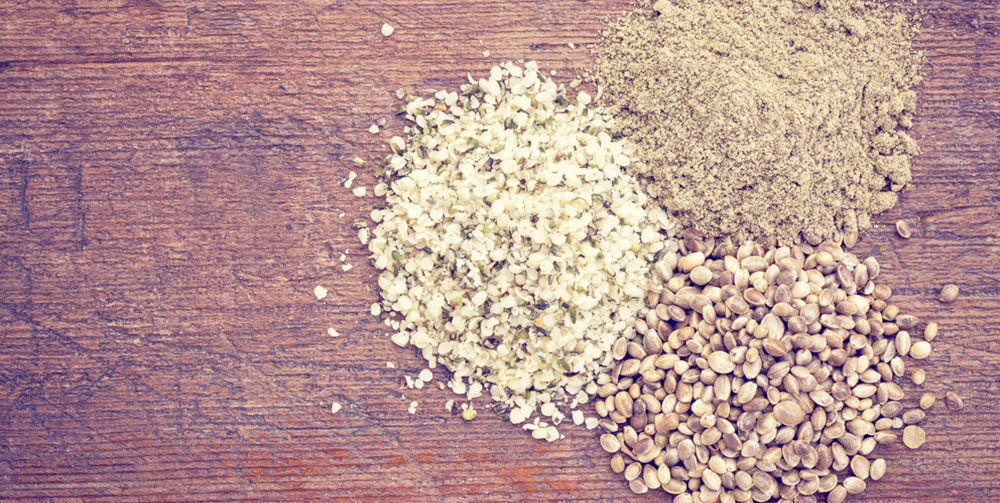Hemp is a reasonably new player in the market of nutritional foods. It shows great promise as a rich source of quality, digestible protein and fatty acids, particularly for vegetarian and vegans.
Background
Protein is a macro nutrient, making up a large portion of daily nutritional intake. Proteins are the building material for every cell in our bodies constituting of 80% of our dry muscle weight; 70% of that our skin and 90% of that our blood.[1,2]
Hemp is one of the earliest domesticated plants known and has been cultivated for thousands of years. It is, in fact, one of the most nutritious foods on the planet, first used in ancient China and India.[3] In far eastern China, hemp was celebrated as one of the seven main grains and was popularly used up until the sixth-century AD in a variety of oriental recipes.[4]
The first recorded use of hemp as food was in the first-century AD writings of Greek physician, botanist and philosopher Dioscorides. The German researcher Immanuel Low referred to a sixth-century Persian name for a preparation of hemp seeds as Royal Grain, which demonstrated the high regard the ancient Persians held for hemp.[5]
Nowadays, modern technological advances have made it possible for shelled hemp seeds to be pressed for oil or cold milled into protein powder and flour as well as roasted or shelled and made into other hemp foods.
Hemp protein is an emerging player in the protein market and boasts many desirable qualities.
It is vegan-friendly, being the richest source of plant-based protein, comprising 20 known amino acids, the essential building blocks of protein. It is a dense source of essential nutrients, including essential fatty acids (EFAs) and is gentle on the digestive system. Furthermore, it contains no known allergens, making it hypoallergenic and it is sustainably grown without the use of herbicides, pesticides or fungicides. Hemp is also not genetically modified and is made in Australia by milling and sieving the hemp meal resulting from the cold-pressing of whole raw organic hemp seeds. No heat is used in the mill head or otherwise, nor any toxic chemical processes are used in its yield.
Clinically, Hemp best suits consumers looking for a high quality and nutrient-dense protein source of plant origin. It’s ideal for people with allergies and intolerances to other protein alternatives, such as dairy and soy. Its easy digestibility makes it an ideal choice for those in need of increased protein such as vegans, vegetarians, athletes and convalescents.
Nutritional Content
PROTEIN
One of the richest sources of protein in nature comes from hemp.[6]
Hemp is 50-60% protein and has an excellent amino acid profile. It is the only plant-based protein that stores its protein in the form of edestin and albumin, which are highly digestible. It also contains naturally occurring fibre, is high in polyunsaturated fatty acids, very low in carbohydrates, has no sodium and is loaded with B vitamins, minerals and vitamin D3. In facts it is the only plant source of Vitamin D3. This makes hemp a real superfood.[8]
There are 21 amino acids that are essential to human health & survival. A protein is considered “complete” when it contains all nine essential amino acids in a sufficient quantity and ratio to meet the body’s protein requirements.[2,9,10] A “complete” protein is not commonly found in plant derived amino acid compositions.
Hempseed contains all eight essential amino acids thus making it a complete protein [2,7] comparable to common animal sources of protein such as meat, milk and eggs. These contain the eight essential amino acids in the same proportion that our body uses them and two semi-essential amino acids (EAAs) that our bodies cannot produce.[1]
Dietary proteins are organic molecules composed of one or more chains of approximately twenty different kinds of amino acids and have a variety of vital functions.[1] Protein is classified as either structural (fibrous), such as collagen and keratin in the skin and hair, or biologically active (globular) found in haemoglobin, hormones, antibodies and enzymes.
Hemp is a bioactive (globular) protein that, when broken down by the body, transforms back into an amino acid which is then used to create one of the many proteins which the body requires. If the amino acid, for example, was part of a globular protein, such as hemp, it could be turned into a fibrous protein and visa versa therefore aiding in muscle repair.[1,11]
Globular proteins are also precursors for some of the most vital chemicals in the body: haemoglobin (which transports oxygen), hormones (which regulate all the bodily processes), antibodies (immunoglobulins, which fend off invading antigens and pathogens) and enzymes (which catalyse and control biochemical reactions).[1,11]
Hemp protein is free of tryspin inhibitors, which block protein absorption and free of oligosaccharides (commonly found in soy), which can cause stomach upset and gas.[8,10,12] The simple proteins in hemp are predominantly composed of edestin, albumin and glutamic acid.[7,10]
Edestin
The goblin edestin, is the most potent protein source of plant origin and comprises 65% of the protein contained in hemp seeds. It closely resembles the globulin found in blood plasma and is compatible with the human digestive system.[2,10]
The name edestin is derived from the Greek meaning “edible”. Edestin functions to aid digestion, is low in phosphorus and is considered to be the backbone of human cellular DNA. It is also vital to the maintenance of a healthy immune system and is used to manufacture antibodies (immunoglobulin).
Albumin
Albumin protein is another high quality globulin protein similar to that of egg whites. It is currently the industry standard when it comes to protein evaluation. Albumin comprises 35% of the protein in hemp, it is highly digestible and a major source of free radical scavengers.
FATTY ACIDS
Hemp seeds contain the highest concentration of EFAs found in any food on the planet, [1,2] including alpha-linolenic acid (ALA), an omega-3 supersaturated EFA, and linoleic acid (LA), an omega-6 polyunsaturated EFA.
Research on humans and animals suggests that optimal brain health is achieved when LA and ALA are consumed in a ratio between 3.5:1 and 4:1 – a ratio which is reflected naturally in hemp.[13]
Hemp is a unique source of the long chain fatty acids stearidonic acid (SDA) and gamma linolenic acid (GLA) which help the body facilitate more efficient conversion of omega-3 and omega-6 EFAs more effectively.[14]
EFAs such as LA and ALA are not naturally made by the human body but are required for mechanisms such as glucose transport, membrane stability, cellular oxygenation and cellular energy.[13]
OTHER NUTRIENTS
Hemp seeds are also high in a number of essential nutrients including chlorophyll, magnesium, potassium, sulphur, phytosterols, ascorbic acid, betacarotene, calcium, fibre, histidine, iron, potassium, phosphorus, riboflavin, niacin and thiamin, as well as insoluble fibre.
Hemp vs marijuana
Hemp is not marijuana and vice versa, as the public has been led to believe for 60 years.
Both share the same genus and, according to most taxonomists, the same species: Cannabis sativa. Both produce the same organic compounds known as cannabinoids, which are unique to the genus Cannabis. The two main compounds, delta-9-tetrahydrocannabinol (THC), i.e. the most psychoactive cannabinoid, and cannabidiol (CBD) are found in both hemp and marijuana.
However, both hemp and marijuana show significant differences with respect to the concentration and relative abundance of these two cannabinoids.
Drug varieties, summarily referred to as marijuana, contain in their female flowers typically 2-5% of THC, but THC levels of as high as 15-20% are not uncommon. Industrial hemp varieties, on the other hand, which are licensed for farming in the European Union and Canada, must be bred to maintain a THC content of less than 0.3%.
In addition, hemp and marijuana differ in their ratio of THC to CBD. CBD has been shown to block the psychoactivity of THC. Industrial hemp contains more CBD than THC, i.e. has a CBD:THC ratio of greater than one, while marijuana contains often significantly more THC than CBD.
Both the low THC content and the high CBD:THC ratio make industrial hemp unsuitable for producing psychoactive effects when smoked or eaten. The high CBD concentration also makes the theoretically conceivable concentration and recovery of THC in hemp technically difficult and economically unfeasible.[2,15]
References
- Dalotto T. The hemp cookbook: from seed to shining seed. Rockchester, Vermont: Healing Arts Press; 2000.
- Callaway JC. Hempseed as a nutritional resource: an overview. Euphytica 2004;140(1-2):65-72. [Abstract]
- Lees RC. Cannabis sativa Seu Indica: Indian hemp. BMJ 1895;1(1780):300-301. [Full Text]
- Abel EL, Abel EL. Marihuana, the first twelve thousand years. New York: Plenum Publishing Co.,N.Y., 1980.
- Robinson R. The great book of hemp: the complete guide to the commercial, medicinal and psychotropic uses of the world’s most extraordinary plant. Rochester, VT: Inner Traditions Bear & Company, 1995.
- Clarke RC, Merlin MD. Cannabis: evolution and ethnobotany. Plant ecology and evolution. University of California Press, 2013.
- Osburn L. Hemp seed: the most nutritionally complete food source in the world. Hemp Line Journal 1992;1(2):12-13. [Full Text]
- Hemp Foods Australia 2014. [Link]
- Wang XS, Tang CH, Yang XQ, et al. Characterization, amino acid composition and in vitro digestibility of hemp (Cannabis sativa L.) proteins. Food Chemistry 2008;107(1):11-18. [Abstract]
- House JD, Neufeld J, Leson G. Evaluating the quality of protein from hemp seed (Cannabis sativa L.) products through the use of the protein digestibility-corrected amino acid score method. J Agricultural Food Chem 2010;58(22):11801-11817. [Abstract]
- Lodish H, Berk A, Zipursky SL, et al. Molecular cell biology. 4th edition. New York: W. H. Freeman, 2000.
- Hemp Industries Association (HIA) 2014. [Link]
- Benhaim P. How hemp seed oil could offer new hope to epilepsy sufferers. NutraIngredients.com 2015. [Link]
- Budwig J. Flax oil as a true aid against arthritis, heart infraction, cancer and other diseases. Apple Publishing: Vancouver, 1994.
- Industrial hemp information and advocacy. Vote Hemp 2015. [Link]
- Manitoba Harvest Hemp Foods 2015 [Link]
DISCLAIMER:
The information provided on FX Medicine is for educational and informational purposes only. The information provided on this site is not, nor is it intended to be, a substitute for professional advice or care. Please seek the advice of a qualified health care professional in the event something you have read here raises questions or concerns regarding your health.


